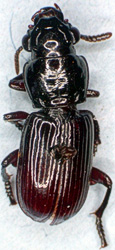Morionidius
Kipling Will- Morionidius charon
- Morionidius doriae
- Morionidius erebus
- Morionidius inexpectatus
- Morionidius insularis
Introduction
Five species distributed in the Oriental region. No key to species exists. Individuals have been found in rotten logs and at lights.
Characteristics
Small to medium sized, deep-bodied species readily recognized from all other morionines by the transverse sulci on the abdominal ventrites.
Morionidius and Stereostoma share the expanded apical labial palpomeres and have a significant number of shared characteristics of other morionines. Morionidius has features of the head and eyes that are intermediate between those found in Stereostoma and other morionines. The eyes in Morionidius species are very prominent, like Stereostoma, but have prominent tempora as in other morionines, which is lacking in Stereostoma. The labrum is also intermediate in form, very slightly emarginate, not straight as in Stereostoma nor deeply emarginate as in Morion. Morionidius lacks the prominently developed latero-apical spine of the protibia, which is very large in all other morionines. The transverse sulci of the abdominal ventrites in Morionidius is not found in any other morionine taxa but is known in various other pterostichine-grade taxa.
The female reproductive structures of Morionidius species are quite different and probably derived relative to those of other morionine taxa. The notched gonocoxite-2 is likely a synapomorphy for the genus. Notched gonocoxites and a sclerotized spermatheca is also found in species of Tshitsherinella Semenov (Chaetodactylini). Both of these taxa also have securiform labial papli and sulcate abdominal ventrites. Chaetodactylines are known to be parasites of scarab beetles (Jeannel 1948) and it is possible that Morionidius also has a parasitic life-style that led to the independent acquisition of these features.
Title Illustrations

| Scientific Name | Morionidius doriae |
|---|---|
| Specimen Condition | Dead Specimen |
| Life Cycle Stage | Adult |
| View | Dorsal |
| Image Use |
 This media file is licensed under the Creative Commons Attribution License - Version 3.0. This media file is licensed under the Creative Commons Attribution License - Version 3.0.
|
| Copyright |
© 2005 Kipling Will

|
About This Page
Kipling Will

University of California, Berkeley, California, USA
Correspondence regarding this page should be directed to Kipling Will at
Page copyright © 2005 Kipling Will
 Page: Tree of Life
Morionidius.
Authored by
Kipling Will.
The TEXT of this page is licensed under the
Creative Commons Attribution License - Version 3.0. Note that images and other media
featured on this page are each governed by their own license, and they may or may not be available
for reuse. Click on an image or a media link to access the media data window, which provides the
relevant licensing information. For the general terms and conditions of ToL material reuse and
redistribution, please see the Tree of Life Copyright
Policies.
Page: Tree of Life
Morionidius.
Authored by
Kipling Will.
The TEXT of this page is licensed under the
Creative Commons Attribution License - Version 3.0. Note that images and other media
featured on this page are each governed by their own license, and they may or may not be available
for reuse. Click on an image or a media link to access the media data window, which provides the
relevant licensing information. For the general terms and conditions of ToL material reuse and
redistribution, please see the Tree of Life Copyright
Policies.
- First online 21 February 2005
- Content changed 07 July 2006
Citing this page:
Will, Kipling. 2006. Morionidius. Version 07 July 2006 (under construction). http://tolweb.org/Morionidius/28913/2006.07.07 in The Tree of Life Web Project, http://tolweb.org/








 Go to quick links
Go to quick search
Go to navigation for this section of the ToL site
Go to detailed links for the ToL site
Go to quick links
Go to quick search
Go to navigation for this section of the ToL site
Go to detailed links for the ToL site